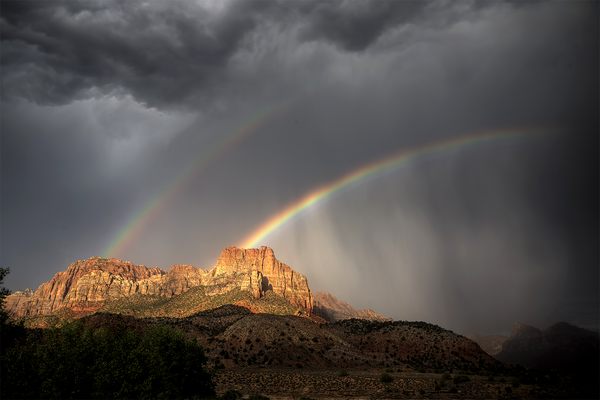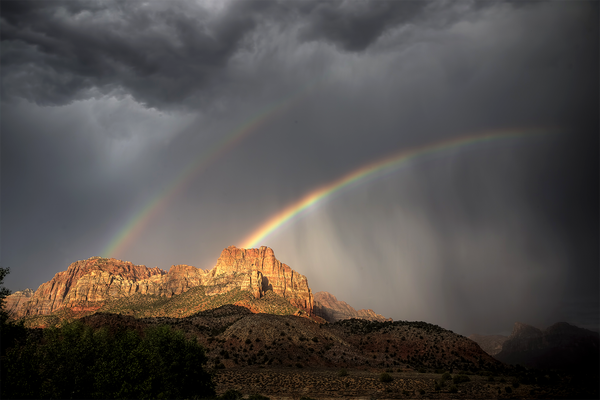
[ad_1]
February 8, 2024
4 min read
A gloom and doom approach does not always spur climate action, it turns out. A new study tells you when it works and when it doesn’t

A double rainbow appears during a monsoonal thunderstorm at Zion National Park, Utah.
Another year of record fossil fuel burning leading to record high global temperatures. Time is running out to solve the climate crisis, and catastrophe looms. You’re probably used to such headlines, and if you are like us, you have already had your moment of gloom when you felt hopeless about the future. But can you turn the doom-induced hopelessness into meaningful change? Our recent global study says yes—but these messages must be used wisely.
In 2019 David Wallace-Wells published the archetypal portrait of climate doom. In his book The Uninhabitable Earth: Life After Warming, he painted a terrifying landscape of the suffering awaiting us if we don’t address climate change. Like those gloomy headlines, it left many people feeling paralyzed with helplessness, fear, and disbelief.
Not everyone is a fan of the doom and gloom messaging. Climate scientists like Michael Mann have warned against climate “doomerism,” messaging that can depress and demoralize the public, assuming that helplessness will simply lead to further climate inaction. And the title of a new book by Hannah Ritchie states clearly that it’s Not the End of the World: How We Can Be the First Generation to Build a Sustainable Planet.
On supporting science journalism
If you’re enjoying this article, consider supporting our award-winning journalism by subscribing. By purchasing a subscription you are helping to ensure the future of impactful stories about the discoveries and ideas shaping our world today.
There is, however, some evidence that doom and gloom messaging can spur climate action, as long as it falls on the right ears at the right time. For example, research has found that climate distress, climate anger and climate anxiety are all associated with increased climate action under some circumstances.
To help figure out the precise impact of climate doomerism, we recently completed one of the largest experiments ever conducted on climate change behavior. Together with an international team of 255 other behavioral scientists and climate change experts, we tested the effects of the 11 top psychological messages meant to boost climate awareness and action. This allowed us to test the impact of doom and gloom messaging against the other top climate change messages (selected by our team of experts).
We recruited a large and diverse sample of over 59,440 participants from 63 countries, and tested interventions ranging from emphasizing scientific consensus (e.g., noting that “99 percent of expert climate scientists” agree on the climate change facts), or the widespread concern of others (e.g., a majority of people in each nation is concerned), to emphasizing the consequences in one’s region (e.g., increased frequency and severity of wildfires and floods) or the effects of climate change on future generations (e.g., asking participants to imagine writing a letter about their actions regarding climate change that would be read decades from now).
Our paper was recently published at the journal Science Advances, where our findings revealed that doom and gloom messaging was highly effective for stimulating climate change information sharing, like posting on the Internet or social media, where negativity reigns. In light of these findings, Wallace-Wells was right in using this messaging style in his writings.
But Mann and Ritchie were also right to assume that doom and gloom can demoralize the public into inaction. We found that this strategy had no effect on policy support or climate beliefs; for these outcomes, writing a letter to a future generation member explaining one’s climate actions today, or thinking about the consequences of climate change in one’s region, were the most effective interventions. Doom and gloom even backfired when it came to more effortful behavior. Hearing these messages actually decreased people’s pro-environmental behavior, which we measured as effort dedicated to planting trees. When faced with the enormous stakes of the climate crisis, individual-level actions might seem futile.
So doom and gloom messaging can do both things: induce helplessness, discouraging individual-level action; but also motivate people to spread the word.
Many other messages also failed or backfired when push came to shove. This underscores how difficult it is to actually mobilize real, effortful action on climate change. This is why collective action—rather than a focus on individual actions—might be necessary to trigger real progress.
We also found that different people responded differently to the various climate messages and that this varies from one country to the next. To design the most effective messages, scientists and policy makers will need to tailor them to the right audience. To see the effects of our interventions along dimensions such as country of residence, income level, age, ideological leaning, socioeconomic status, gender and also type of climate action targeted, we created an open-access and user-friendly Web app.
To our disappointment, we did not find any silver bullet for spurring climate action. But our research found several messages that moved the needle on climate change beliefs and actions. This suggests that understanding how different messages work, and in what contexts, will be critical to changing beliefs, spreading the word, and mobilizing action.
This is an opinion and analysis article, and the views expressed by the author or authors are not necessarily those of Scientific American.
[ad_2]